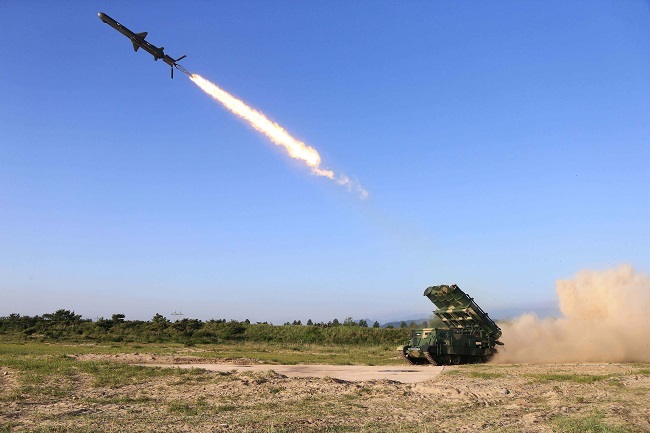Can North Korea conduct first ICBM test within this year?
By Yeo Jun-sukPublished : June 11, 2017 - 15:46
With North Korea successfully test-firing most of its advanced missiles revealed during the regime’s massive military parade on April 15, there is only one missile type left for the regime to finish its ultimate goal: an intercontinental ballistic missile capable of reaching the United States.
Since the military parade, the North has launched a series of newly-introduced ballistic missiles with extended ranges, advanced engines and multiple platforms. Among them are the intermediate-range Hawsong 12, solid-fueled Pukguksong-2 and Scud-type missiles targeting US warships.
Combined with rumors that the North placed an ICBM in large canisters delivered by two vehicles during the April parade, Pyongyang’s relentless missile tests have prompted speculation on whether the regime could conduct its first ICBM test within this year.
Since the military parade, the North has launched a series of newly-introduced ballistic missiles with extended ranges, advanced engines and multiple platforms. Among them are the intermediate-range Hawsong 12, solid-fueled Pukguksong-2 and Scud-type missiles targeting US warships.
Combined with rumors that the North placed an ICBM in large canisters delivered by two vehicles during the April parade, Pyongyang’s relentless missile tests have prompted speculation on whether the regime could conduct its first ICBM test within this year.

“North Korea is poised to conduct its first ICBM test in 2017,” Robert Soofer, deputy assistant secretary of defense for nuclear and missile defense policy, was quoted by the Japanese Kyodo news service as saying at a hearing of the US Senate Armed Services Committee on Wednesday.
Vice Adm. James Syring, the head of US Missile Defense Agency, also adopted a similar tone, saying that he assumes that Pyongyang could “range” the US with a nuclear-tipped ICBM and that the technological breakthrough shown in recent tests had caused him “great concern.”
In an editorial published Saturday, North Korea state-run newspaper Rodong Sinmun reiterated its claim that the regime is “not far away” from launching an ICBM. Its leader Kim Jong-un said in his annual address that the regime is in the final stage of developing ICBM technology.
Although the North’s claim was not verified by the US military and South Korean Defense Ministry, which declined to comment on the Rodong Sinmun report, the regime appears to be only a few steps away from deploying an ICBM, analysts suggested.
The most significant breakthrough was shown in the May 14 test of Hwasong 12, a single-stage missile which flew 787 kilometers, after being fired on a lofted trajectory with apogee of 2,111.5 kilometers. Analysts suggested that the projectile could have flown about 5,000 km if fired on a range-maximizing ballistic trajectory
“Of all the missiles that North Korea has fired until now, Hwasong-12 is the closest one to the ICBM,” said Yang Uk, a senior research fellow at the Korea Security and Defense Forum. “As long as the North can find a way to better use its technology for stage separation, it can fire an ICBM-level missile.”
Given that the missile was considered to be a single-stage rocket using a single main engine, analysts suspected that if the North figured out a way to cobble together multiple rockets and engines, the Hwasong 12 would fly a distance equivalent of ICBM.
Yang noted that Hwasong’s use of a newly-developed high-thrust engine alone could offer North Korea a path to the ICBM. Touted as “revolutionary” since its demonstration in March, the indigenously-developed engine had a thrust of 80 tons and was reportedly used for the Hwasong 12.
Jeffrey Lewis, the director of the East Asia non-proliferation program at the Middlebury Institute of International Studies, agreed that the engine would serve as a significant milestone in the North’s efforts to develop an ICBM capable of reaching the US.
“(I believe the engine) is capable of carrying a nuclear weapon about 3,000 miles -- just short of the technical definition of an ICBM (about 5500 kilometers) and capable of striking Guam and the Aleutian Islands,” said Lewis in an article published in Foreign Affairs.
“Although the Hwasong-12 is not an ICBM, it represents a domestic capacity to design engines that should ultimately manifest itself in far more capable missiles,” he said.
By Yeo Jun-suk (jasonyeo@heraldcorp.com)



![[Exclusive] Korean military set to ban iPhones over 'security' concerns](http://res.heraldm.com/phpwas/restmb_idxmake.php?idx=644&simg=/content/image/2024/04/23/20240423050599_0.jpg&u=20240423183955)




![[Pressure points] Leggings in public: Fashion statement or social faux pas?](http://res.heraldm.com/phpwas/restmb_idxmake.php?idx=644&simg=/content/image/2024/04/23/20240423050669_0.jpg&u=)

![[Herald Interview] 'Amid aging population, Korea to invite more young professionals from overseas'](http://res.heraldm.com/phpwas/restmb_idxmake.php?idx=644&simg=/content/image/2024/04/24/20240424050844_0.jpg&u=20240424200058)








